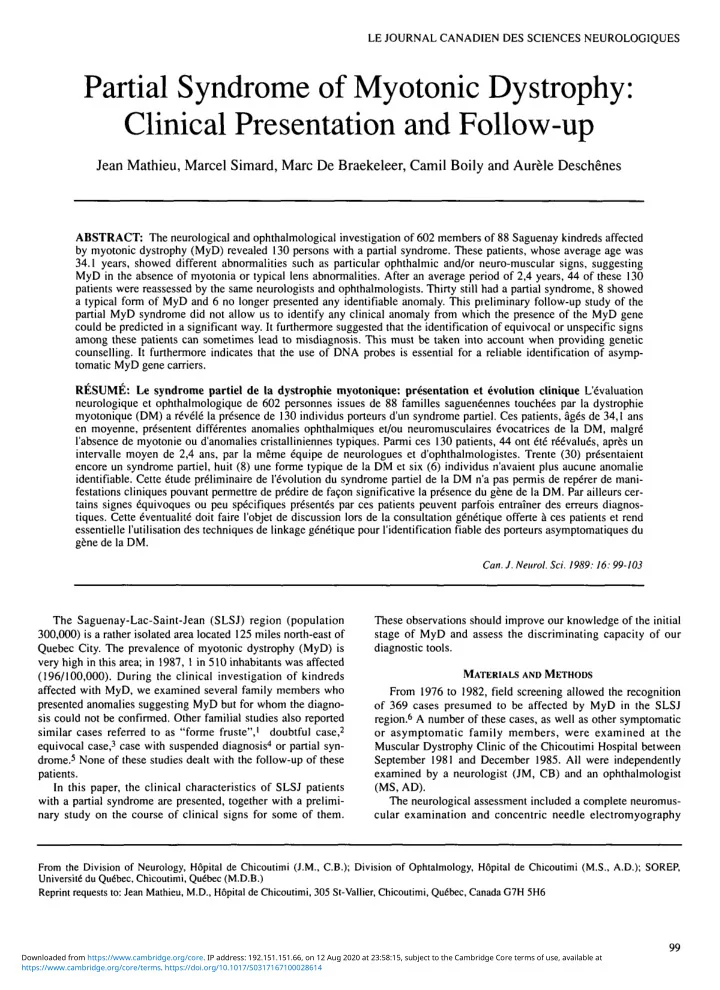

LE JOURNAL CANADIEN DES SCIENCES NEUROLOGIQUES Partial Syndrome of Myotonic Dystrophy: Clinical Presentation and Follow-up Jean Mathieu, Marcel Simard, Marc De Braekeleer, Camil Boily and Aurele Deschenes ABSTRACT: The neurological and ophthalmological investigation of 602 members of 88 Saguenay kindreds affected by myotonic dystrophy (MyD) revealed 130 persons with a partial syndrome. These patients, whose average age was 34.1 years, showed different abnormalities such as particular ophthalmic and/or neuro-muscular signs, suggesting MyD in the absence of myotonia or typical lens abnormalities. After an average period of 2,4 years, 44 of these 130 patients were reassessed by the same neurologists and ophthalmologists. Thirty still had a partial syndrome, 8 showed a typical form of MyD and 6 no longer presented any identifiable anomaly. This preliminary follow-up study of the partial MyD syndrome did not allow us to identify any clinical anomaly from which the presence of the MyD gene could be predicted in a significant way. It furthermore suggested that the identification of equivocal or unspecific signs among these patients can sometimes lead to misdiagnosis. This must be taken into account when providing genetic counselling. It furthermore indicates that the use of DNA probes is essential for a reliable identification of asymp- tomatic MyD gene carriers. RESUME: Le syndrome partiel de la dystrophic myotonique: presentation et evolution clinique devaluation neurologique et ophthalmologique de 602 personnes issues de 88 families sagueneennes touchees par la dystrophic myotonique (DM) a revele la presence de 130 individus porteurs d'un syndrome partiel. Ces patients, ag6s de 34,1 ans en moyenne, presentent differentes anomalies ophthalmiques et/ou neuromusculaires evocatrices de la DM, malgre l'absence de myotonie ou d'anomalies cristalliniennes typiques. Parmi ces 130 patients, 44 ont ete reevalues, apres un intervalle moyen de 2,4 ans, par la meme equipe de neurologues et d'ophthalmologistes. Trente (30) presentaient encore un syndrome partiel, huit (8) une forme typique de la DM et six (6) individus n'avaient plus aucune anomalie identifiable. Cette etude preliminaire de revolution du syndrome partiel de la DM n'a pas permis de reperer de mani- festations cliniques pouvant permettre de predire de facon significative la presence du gene de la DM. Par ailleurs cer- tains signes equivoques ou peu specifiques presented par ces patients peuvent parfois entrainer des erreurs diagnos- tiques. Cette eventualite doit faire l'objet de discussion lors de la consultation genetique offerte a ces patients et rend essentielle l'utilisation des techniques de linkage genetique pour l'identification fiable des porteurs asymptomatiques du gene de la DM. Can. J. Neurol. Sci. 1989:16: 99-103 The Saguenay-Lac-Saint-Jean (SLSJ) region (population These observations should improve our knowledge of the initial 300,000) is a rather isolated area located 125 miles north-east of stage of MyD and assess the discriminating capacity of our Quebec City. The prevalence of myotonic dystrophy (MyD) is diagnostic tools. very high in this area; in 1987, 1 in 510 inhabitants was affected (196/100,000). During the clinical investigation of kindreds MATERIALS AND METHODS affected with MyD, we examined several family members who From 1976 to 1982, field screening allowed the recognition presented anomalies suggesting MyD but for whom the diagno- of 369 cases presumed to be affected by MyD in the SLSJ sis could not be confirmed. Other familial studies also reported region. 6 A number of these cases, as well as other symptomatic similar cases referred to as "forme fruste", 1 doubtful case, 2 or asymptomatic family members, were examined at the equivocal case, 3 case with suspended diagnosis 4 or partial syn- Muscular Dystrophy Clinic of the Chicoutimi Hospital between drome. 5 None of these studies dealt with the follow-up of these September 1981 and December 1985. All were independently patients. examined by a neurologist (JM, CB) and an ophthalmologist In this paper, the clinical characteristics of SLSJ patients (MS, AD). with a partial syndrome are presented, together with a prelimi- The neurological assessment included a complete neuromus- nary study on the course of clinical signs for some of them. cular examination and concentric needle electromyography From the Division of Neurology, Hopital de Chicoutimi (J.M., C.B.); Division of Ophtalmology, Hopital de Chicoutimi (M.S., A.D.); SOREP, University du Qudbec, Chicoutimi, Quebec (M.D.B.) Reprint requests to: Jean Mathieu, M.D., Hopital de Chicoutimi, 305 St-Vallier, Chicoutimi, Quebec, Canada G7H 5H6 99 Downloaded from https://www.cambridge.org/core. IP address: 192.151.151.66, on 12 Aug 2020 at 23:58:15, subject to the Cambridge Core terms of use, available at https://www.cambridge.org/core/terms. https://doi.org/10.1017/S0317167100028614
Recommend
More recommend